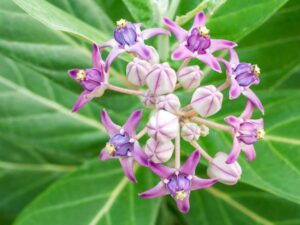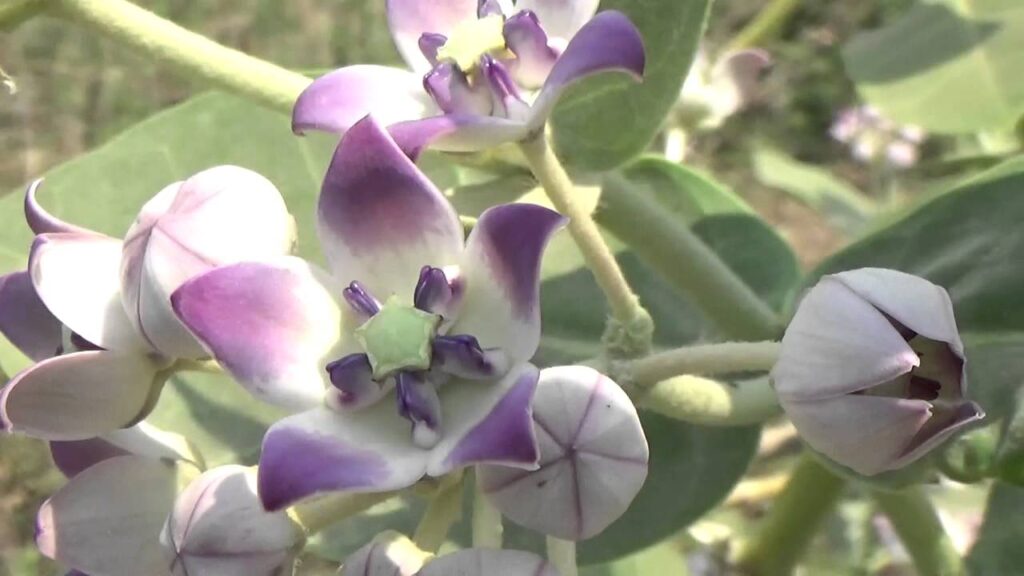Herb
Arka (Calotropis gigantea) Herb Ayurvedic Overview
Arka (Calotropis gigantea) is a perennial shrub having a 2.5-meter in height. It is a widespread and valuable herb seen widely throughout India. It mainly consists of dried roots of Calotropis gigantea (Ait.) R. Br. (Fam. Asclepiadaceae). Arka has a bunch of flowers that are white or lavender. It has a milky stem and is rich in cardiac glycosides, calcium oxalate, and fatty acid.
Calotropis gigantea is commonly found in most parts of the world with a warm climate, dry, sandy, and alkaline soil. The leaves of Arka (Calotropis gigantea) are sessile and sub-sessile, opposite, ovate, cordate at the base. The flowers are about 3.8 to 5.1 cm in size, with umbellate lateral cymes, and are colored white to pink. The seeds are broadly oval, compressed with a tufted micropylar coma of long silky hair.
The milky discharge of the Arka (Calotropis gigantea) has abortifacient (causing abortion), spasmogenic and carminative, anti-dysenteric, anti-syphilitic, anti-rheumatic, antifungal, diaphoretic properties and widely used in the treatment of leprosy, bronchial asthma, and skin diseases. The powder of root bark is traditionally used for getting relief in diarrhea, stomach ulcers, intestinal worm, and dysentery as it has carminative properties and helpful in indigestion.
Table of Contents
Scientific Classification of Arka (Calotropis gigantea):
- Family: Apocynaceae
- Sub family: Asclepiadoideae
- Scientic Nmae: Calotropis gigantea
- Higher Classification: Calotropis
- Order: Gentianales
- Tribe: Asclepiadear
- Rank: Species
Arka (Calotropis gigantea) Synonyms:
- Sanskrit: Ravi, Bhanu Tapana
- Assamese: Akand, Akan
- Bengali: Akanda, Akone
- English: Madar Tree
- Gujrati: Aakado
- Hindi: Aak, Madar, Akavana
- Kannada: Ekka, Ekkadagida, Ekkegida
- Kashmiri: Acka
- Malayalam: Erikku
- Marathi: Rui
- Oriya: Arakha
- Punjabi: Ak
- Tamil: Vellerukku, Erukku
- Telugu: Jilledu
- Urdu: Madar, Aak
 Arka (Calotropis gigantea) Description:
Arka (Calotropis gigantea) Description:
a) Macroscopic: Arka (Calotropis gigantea) root is rough, externally yellowish-grey while internally white, fissured longitudinally, the central core is cream-colored, bark easily separated from xylem, the taste is bitter.
b) Microscopic : The transverse section of Arka root shows the outermost cork tissue consisting of 4-8 rows of tangentially elongated cells followed by 3-6 rows of moderately irregular and thick-walled cells secondary cortex devoid of calcium oxalate crystals and starch grains. The cortex is composed of large cells of polyhedral parenchymatous, which contains abundant rounded starch grains.
Some cortical cells contain sieve tubes thick-walled, rosette crystals of calcium oxalate, and phloem consists of sieve elements and parenchyma, which are more prominent towards the inner region of the phloem. Within the phloem, cambium is present, consisting of 2-5 rows of tangentially elongated cells, thin-walled, which forms a central part of root composed of vessels. The fibers, tracheids, and xylem parenchyma, present throughout the xylem region and arranged radially in 2-7. The xylem fibers are long, lignified with wide lumen, tapering on ends, and simple pits on walls.
Identity, Purity, and Strength of Arka (Calotropis gigantea):
- Foreign matter Not more than 2 percent, Appendix 2.2.2
- Total Ash Not more than 4 percent, Appendix 2.2.3
- Acid-insoluble ash Not more than 1 percent, Appendix 2.2.4
- Alcohol-soluble extractive Not less than 2 percent, Appendix 2.2.6
- Water-soluble extractive Not less than 8 percent, Appendix 2.2.7
Chemical Constituents of Arka (Calotropis gigantea):
Arka (Calotropis gigantea) contained many biological active chemical groups including, cardenolides, steroids, tannins, glycosides, phenols, terpenoids, sugars, flavonoids, alkaloids, and saponins.
Ayurvedic Properties and Action of Arka (Calotropis gigantea):
• Rasa: Katu, Tikta
• Guna: Laghu
• Virya: Ushna
• Vipaka: Katu
• Karma: Kaphavata hara, Deepan, Bhedan, Krimighan, Vranahara, Vishaghana, Kushthaghana, Pleehahara, Sangrahi, Shoth hara.
Ayurvedic Formulation made by Arka (Calotropis gigantea):
The primary formulation of Arka is Maha Vishagarbha Taila, Dhanvantara Ghrita, Asanadi Kashaya, Arkadi Kshaya, Ardraka Ghrita.
Therapeutic Uses of Arka (Calotropis gigantea):
The main therapeutic uses of Arka are Kandu, Kushtha, Krimiroga, Gulam, Udar roga, Vrana, Shwas.
Dose of Arka (Calotropis gigantea):
1-3 gm of the drug for decoction.
Reference:
Ayurvedic Pharmacopeia of India.


